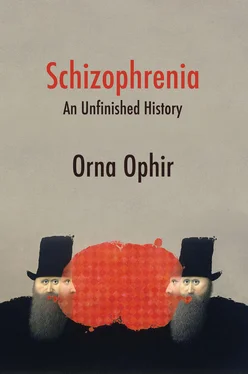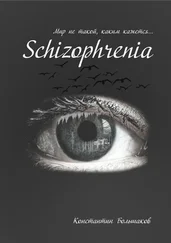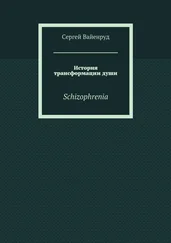Another classification system was offered by the celebrated French physician Philippe Pinel (1745–1826), with whom we opened this section, who suggested turning back to detailed clinical observation, noting the course of disease, and incorporating the patient’s life history. In his Medico-Philosophical Treatise on Mental Alienation or Mania , Pinel presented a classification of mental disorders that included four classes of insanity: maniacal insanity, melancholia, dementia, and idiocy. 87Maniacal insanity, according to Pinel, was typically temporary – yet sometimes chronic – and frequently curable. Melancholia was defined by “a dreamy taciturn manner, touchy and suspicious, with a desire to be left alone.” 88Dementia was seen as gradually eroding the victim’s thoughts and could not be cured. Finally, idiocy was the term used to describe a condition in which the intellect is not fully developed. These categories were still largely in use until the mid-nineteenth century, when hundreds of other psychiatric classifications were published across Europe.
The stage is now set for the historical and conceptual question that interests us here: what became of the category of schizophrenia when the term was coined, and what led to its diagnosis and definition in the first place?
During this modern Enlightenment period, the concept of mental disease as a cluster of mental symptoms was first introduced, theoretically delineated, and clinically applied. As Berrios notes, descriptive psychopathology was also soon introduced as a new language in the field of mental afflictions. Its method and technical idiom served a new profession, namely “alienism,” which would become the precursor of “psychiatry,” and which, as soon as it emerged, established itself as a trade, a science, and a medical practice. 89During the rise of the asylum system, conflicts erupted between alienists, on the one hand, and legislatures, the clergy, and civil society, on the other.
The idea that complaints were signs of disease allowed mental symptoms to be thought of as smaller units of “mental disease,” understood as a condition, a disorder, or, indeed, an illness. Whether the symptoms were mere exaggerations of “normal” mental functions on a wider spectrum , or whether, on the contrary, they were a categorically distinct new phenomenon was a much-debated question during the nineteenth century. Psychologists tended to argue for the former, and alienists for the latter. 90
Most of the data collected on mental illness during this period came from the asylums. The deplorable sanitary conditions in these institutions – with their overcrowding, outbreaks of epidemics and infections, and downright neglect – led to high mortality rates among patients. In response to these conditions, physicians were legally obliged to be present in the asylums and keep records of their observations. The large cohorts of patients treated in the asylums were considered not as individual sufferers, but rather as inferior, pathological specimens. 91Data collected from these patients then served as a foundation for the newly developed field of psychopathology. 92
One important question for psychopathologists was to determine what differentiates normal from abnormal behavior and experience. And because no biological markers were available to answer this question, deviance from the proper, ethical, and acceptable social norms, together with patients’ self-reports on their state of mind, became the defining criteria to determine mental illness. Indeed, the science of psychopathology, which started out from this “hybrid platform” due to an absence of clear biological markers and tests, has not changed much in its contrary ambition and inclination. To this day, clinicians still base their examinations both on the observed behavior and the subjective experience of the individuals they treat. The latter reveal two opposed aspects of a single phenomenon, which lead to contrasting paradigmatic explanations and self-understandings of the same symptoms (the objectively observed and recorded, on the one hand, and the subjectively experienced and reported, on the other). 93
But the mere differentiation between the normal and the abnormal or the psychopathological, which determined who would be placed in the asylums, was never enough. “The Era of the Asylum,” 94as Edward Shorter, a social historian specializing in the history of the insane, aptly names this period, saw an ever-increasing need to place the mentally ill also in different wings of these institutions. In its footsteps, a further differentiation among those committed to the asylum became necessary. Some criteria used to place patients in different areas of the building were completely unrelated to the person’s illness (e.g., male or female), but some were based on their diagnosis (e.g., agitated or quiet, acute or chronic, rational or irrational, continent or incontinent, epileptic or non-epileptic, organic or functional, criminal or non-criminal). 95
Psychiatry was in fact “a profession in reverse,” writes the sociologist Andrew Abbott. It began with the establishment of its institutions, that is to say, the asylums, and only later developed its expert knowledge regarding the mental illnesses that the residents in these houses supposedly suffered from. 96It was only after the asylums were established that the further professionalization of alienism (i.e., the study, understanding of, and caring for those who suffered from “mental alienation” in Europe and, in this respect, the precursor of psychiatry as a scientific discipline) took place through the development of local professional societies, textbooks, journals, training procedures, and examinations, and perhaps even more importantly, through largely unsuccessful efforts to establish a uniform systematic description of diseases, a so-called nosographic lexicon . 97In the process, the asylums enabled “a minor epistemological revolution,” and theories that assumed that madness was in the body became more and more prevalent. 98
The insanities, during this period, were seen as disorders of the senses and of the movement of the nervous system, without fever or focal lesion. They were differentiated from conditions like Parkinson’s disease and multiple sclerosis, for which clear lesions of the brain were indeed found. It was neurology, the other new profession that emerged during this time, that explicitly aimed to treat these latter conditions. Insanities such as hypochondriasis, hysteria, anxiety disorders, obsessive-compulsive disorder, and neurotic depressions were now named “psychoses,” while the term “neuroses” was reserved for what was increasingly believed to be a psychological conflict. 99
Not only were the “psychoses” contrasted with the “neuroses,” in the nineteenth century the former term also came to replace the more general and colloquial concept of madness, together with the different symptoms that define it such as hallucinations, delusions, mental confusion, irrationality, and thought disorders. Aspiring to offer not merely a symptom-based classification system, but, as in the rest of medicine, a system that classifies different illnesses based on causation (as different diseases may exhibit similar symptoms but nonetheless have distinctive causes), the psychoses were further divided into more specific diagnostic groups during this period: “functional” versus “organic,” “endogenous” or “exogenous,” while “acute and chronic” cases were now also distinguished for the first time. Madness with no “known anatomical lesion” was named “functional psychosis,” and included diagnoses such as delirium hallucinatorium, mania, melancholia , circular psychosis, paranoia, and acute dementia. 100Forms of “organic psychoses,” by contrast, were related to other physical diseases like syphilis, but also to diseases of the brain, such as brain tumors, and to those thought to arise from other nervous disorders, such as epilepsy.
Читать дальше












